Best Indoor Greenhouse

This post follows our research editorial guidelines.

Not everyone is blessed with expansive backyards to relieve their gardening itch. However, you can make do with even the smallest of living spaces if you wish to grow fresh herbs, fruits, vegetables, and flowers. How? Well, the answer is pretty simple: invest in an indoor greenhouse.
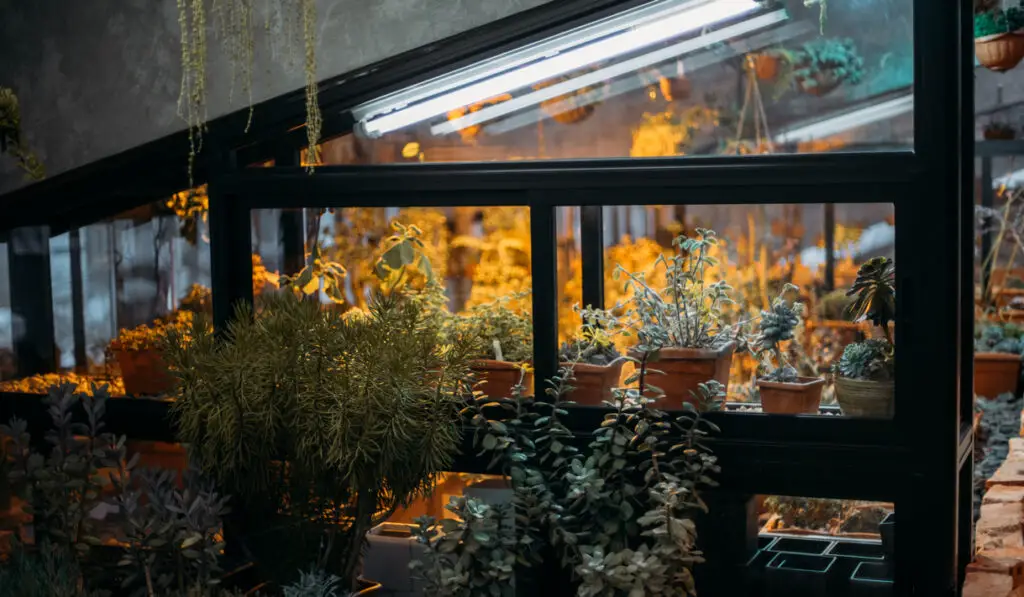
Attention Garden Lovers: This post contains handpicked links to recommended gardening products. If you buy something through these links, I may earn a small commission at no extra cost to you.
An indoor greenhouse is an inexpensive way to turn a dedicated space in your home into a full-fledged garden. You can grow plants within a controlled environment, even when they are off-season. Even people who maintain gardens during the growing season can benefit from starting seeds indoors to transplant later. Indoor greenhouses are budget-friendly and easy to install and maintain. With so many different sizes to choose from there are options to fit one in virtually any kind of space.
Read on as I discuss how you can benefit from an indoor greenhouse and reveal my top picks!
Table of Contents
Why Use a Greenhouse to Grow Food Indoors?
First and foremost, let me answer the most basic questions regarding this topic: why an indoor greenhouse?
Unlike a bulky, hard-to-maintain, traditional outdoor greenhouse, an indoor greenhouse is your ultimate answer to gardening in a small space. You can even set potted plants on a tabletop and be able to find a greenhouse option to use for that small of a stretch. While it works just as well for transplanting seedlings to an outdoor space, the people who benefit the most from an indoor greenhouse are ones with restricted room.
An indoor garden with controlled temperature, optimum air circulation, adequate ventilation, and light can help you grow your own food throughout the year. From rough weather conditions to short growing seasons to lack of the sun, all your gardening problems are solved with this one piece of equipment. Furthermore, research shows that indoor plants can improve mood, boost productivity and clean indoor air pollutants. As researcher Dr. Christian Pfrang said regarding his air quality plant study:
The plants we chose were all very different from each other, yet they all showed strikingly similar abilities to remove NO2 from the atmosphere. This is very different from the way indoor plants take up CO2 in our earlier work, which is strongly dependent on environmental factors such as nighttime or daytime, or soil water content.
Lead researcher Dr. Christian Pfrang
Top 3 Benefits of an Indoor Greenhouse
I am a big fan of indoor greenhouses – anything that is budget-friendly and easy to use? Sign me up! But, gardening all year long is not the only (albeit a huge) reason to invest in your own indoor greenhouse. I think indoor gardening with the help of such greenhouses is much easier than maintaining a traditional garden bed. Apart from ease of use and cost-effectiveness. Here are my 3 top benefits of indoor greenhouses.
Overcome Space Limitations:
The biggest plus of owning an indoor greenhouse is the ability to grow all kinds of plants even if you have no backyard. This makes a greenhouse essential for growing plants indoors without access to garden beds.
Portability:
Another benefit of owning a greenhouse is its portability. You can find indoor greenhouse kits that are easy to set up and just as easy to warp and move to a new house if necessary. Despite their compactness, a portable greenhouse can house various potted plants just like a traditional greenhouse.
Enhanced Plant Protection and Long-Lasting:
Not only do such greenhouses prevent your plant pots from pests, bugs, and harsh weather, but they can also be quite long-lasting. Since greenhouses inside your home do not have to endure natural elements, they do not deteriorate as fast and need much lesser upkeep.
Where to Place Your Indoor Greenhouse?
If you do not need any more convincing on why getting an indoor greenhouse is a splendid idea, let’s get to another essential question: where do you place it?
While it may seem like a trivial question, indoor greenhouse placement can play a vital role in how well your house plants grow. Unfortunately, even the best indoor greenhouses fail to deliver the expected indoor gardening results if they are not placed correctly.
Usually, the best place for an indoor garden is by a window so plants can get adequate direct sunlight. If sunlight exposure is not an option, you can try a combination of grow lights and sunlight. However, if you live in an area where the plants receive little to no natural light, you can rely solely on grow lights, especially during the winter months when sunlight is limited.
Grow lights are specially made to mimic sunlight to help your plant thrive without its natural counterpart. But, sunlight is not the only factor when considering indoor greenhouses’ placement. Air circulation and humidity levels also significantly impact plants that grow indoors. In addition, plants need some percentage of moisture to grow to their full potential. Thus, investing in a hygrometer and humidifier is a good idea.
The biggest reason why plants die in indoor greenhouses is overheating. Suppose your placement does not allow enough air to circulate through the greenhouse. In that case, you may need to buy a small fan to keep the ideal germination temperature, which is usually between 55 to 75 degrees Fahrenheit for different season crops. So keep a check on your greenhouse temperature, especially during the summer.
Thus, ensure adequate light, humidity, and air circulation when selecting a spot for your greenhouse.
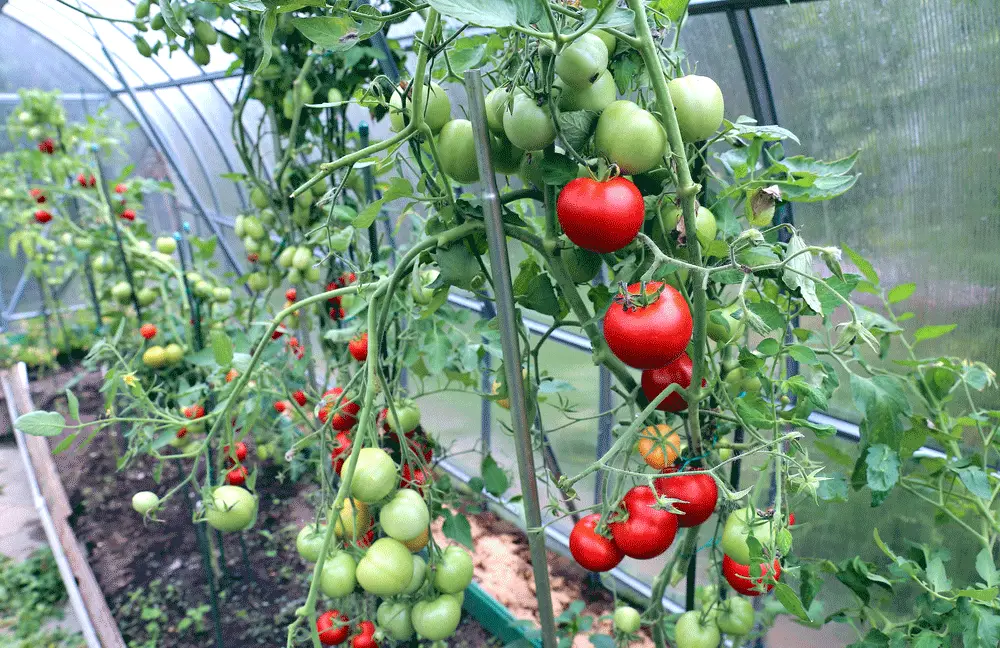
What can you Grow in an Indoor Greenhouse?
Technically speaking, you can grow whatever you can in your indoor garden. However, more than the type of plant, the size of your greenhouse and your floor space dictate what you can and cannot grow indoors. For example, if you have an indoor mini greenhouse, it’s better to stick to herbs and small plants. In contrast, a small indoor greenhouse can be used to grow various vegetables like leafy greens or carrots. Similarly, a larger greenhouse can house small fruit trees and other tall plants.
I would stick to herbs and shorter plants starting off and then experiment with tall plants like tomatoes (which can grow up to 6 feet in height) once you have established the basics of an indoor garden. That said, here is a list of various plants you can grow in a greenhouse inside your home.
List of Herbs
Indoor herb gardens using a mini-greenhouse are often the most popular kind of indoor plants. This is because they are easy to plant and maintain and useful in small quantities.
You can grow the following herbs in an indoor greenhouse.
- basil
- oregano
- parsley
- thyme
- mint
- chives
- rosemary
List of Vegetables
Another reason I love indoor greenhouses is that with a little TLC, they can provide enough food to save you money on monthly groceries, especially if you plant the right kind of vegetables.
You can grow the following vegetables and more in an indoor greenhouse.
- lettuce and other leafy greens
- hot peppers
- carrots
- cucumbers
- spinach
- avocados
- tomatoes
- radishes

List of Fruits
You can also grow various fruits indoors, using an indoor greenhouse to provide the right environment. Some fruits that thrive in such controlled environments include the following.
- strawberries
- limes
- lemons
- oranges
- mulberries
When growing fruit, remember how much space you have and how tall the fruit tree might grow. Smaller plants always work better in an indoor greenhouse, usually because of space restrictions.
3 Best Mini Indoor Greenhouses
If you are really short on space, a mini indoor greenhouse might solve all your gardening problems. As the name suggests, mini-greenhouses are small-sized greenhouses that often come with tiers for intelligent space usage and allow the growth of smaller plants like herbs, lettuce, and succulents. They are the perfect size for an indoor herb garden.
Here are my three top picks and why I love them.
1. Pop-up Mini Greenhouse
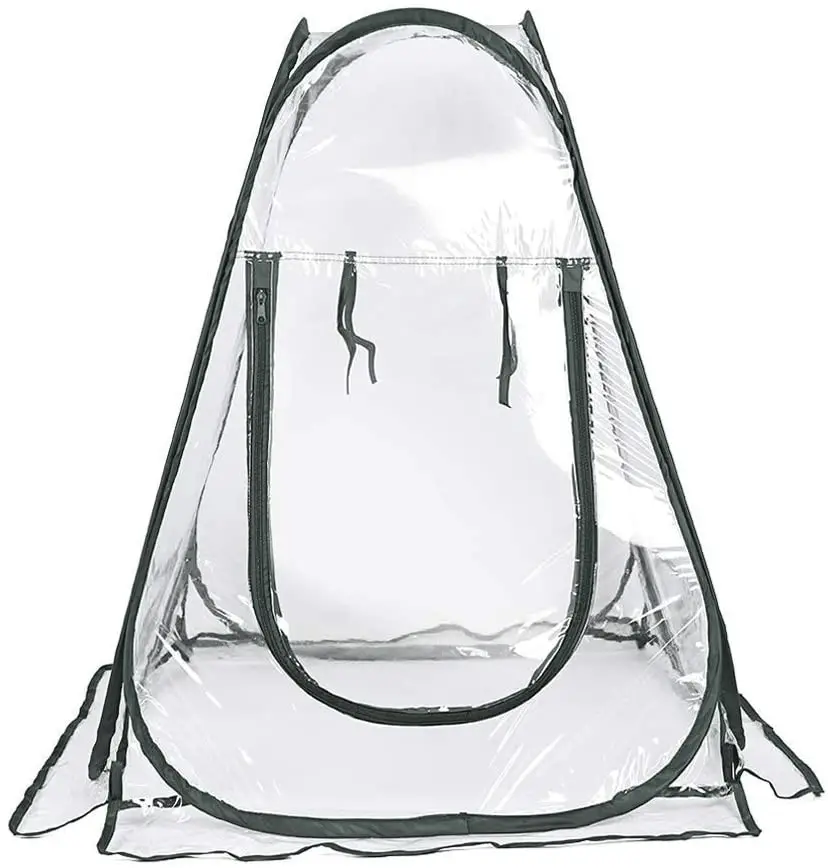
Rating: 4.5/5
The pop-up mini greenhouse takes virtually no time to set up. Just open the package, and you are good to go. The transparent panels allow you to see your plant’s progress while letting in just enough sunlight for healthy propagation. In addition, the zippered roll-up door can easily be opened and tied up for plenty of ventilation.
A bonus with this miniature greenhouse is that it can, not only fit various spaces inside your home but just as easily be used outdoors. You get metal stakes to drive through the four corners of the greenhouse in the ground. I wish a similar stabilizer were also in the package for keeping the greenhouse in place indoors. Nonetheless, simple function and setup earn them a place in my best indoor greenhouse list.
Pros:
- Good value for money
- Sturdy construction
- Zipper is smooth
- Portable
Cons:
- Need bricks to close the sides
- No small vent for little ventilation
2. Ohuhu Mini Greenhouse
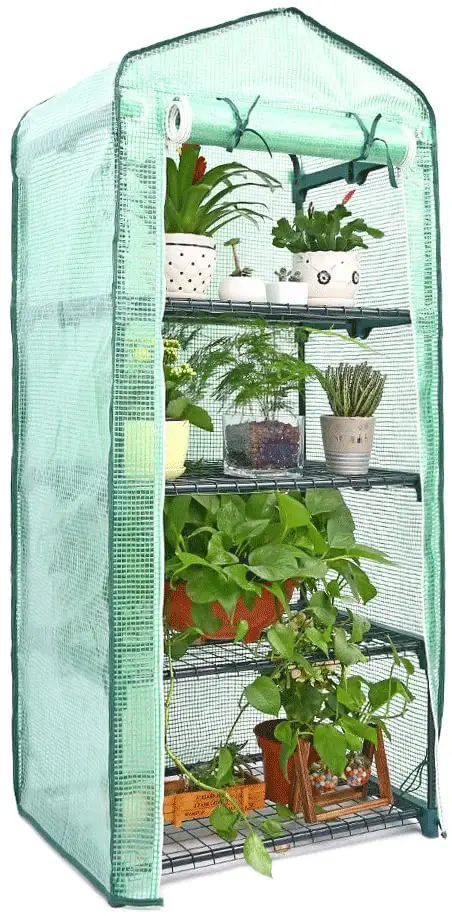
Rating: 4.4/5
If you want to grow more plants in limited space, this vertical Ohuhu Mini Greenhouse is for you. With 4 tiers of steel wire shelves and a steel tube frame, such a durable unit is pretty much unseen in the miniature greenhouse category. This allows for some serious gardening or starting numerous plants at once for the growing season.
This greenhouse has a zippered roll-up door and screened panels for proper air circulation. However, some units can be shaky or have a rough zipper. Their customer service is also top-notch, often responding to troubleshooting questions within the day which is faster than I can say for most larger companies selling similar products.
Pros:
- Sturdy construction
- Can house numerous plants
- Excellent customer service
- Needs a relatively bigger space
Cons:
- Some units can be wobbly
- Zipper can be a bit sticky
3. Palm Springs 2 -Tier Mini Greenhouse with Roll-up Zipper Door
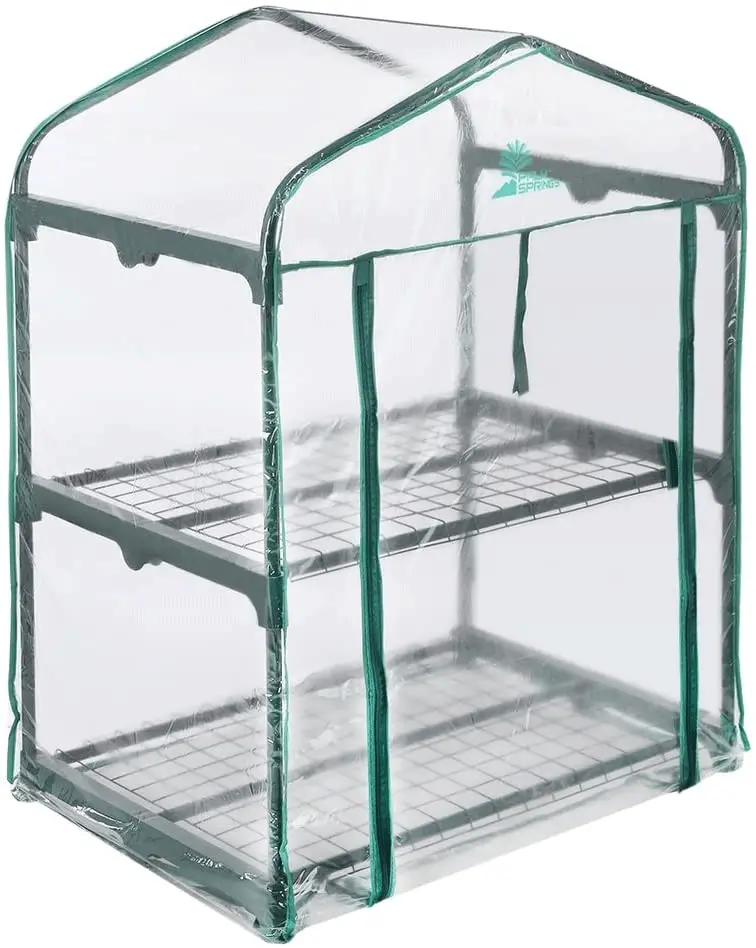
Rating: 4.4/5
Next on my list of the best indoor mini greenhouse is the Palm Springs 2-Tier unit. This lightweight unit has two steel wire shelves with a PVC cover. The zipper roller door gives you easy access to the plants or seed trays. The design is sleek and just the right size for a functional indoor greenhouse.
However, the tiers can only take 11 lbs. of weight, so it’s not exactly sturdy enough to house bigger pots for long unless supported otherwise.
Pros:
- Easy to assemble
- Great size for indoors
- Excellent to start seeds
Cons:
- Not the sturdiest greenhouse out there
Best Indoor Greenhouse Overall: My Top 3 Picks
Most indoor greenhouses are small enough to fit in patios, balconies, and apartments. However, some walk-in options allow more room for the user. Keeping in mind versatility, ease of use, and practicality, here are my 3 top picks for the best indoor greenhouses.
1. Worth Garden 4 Tier Portable Greenhouse
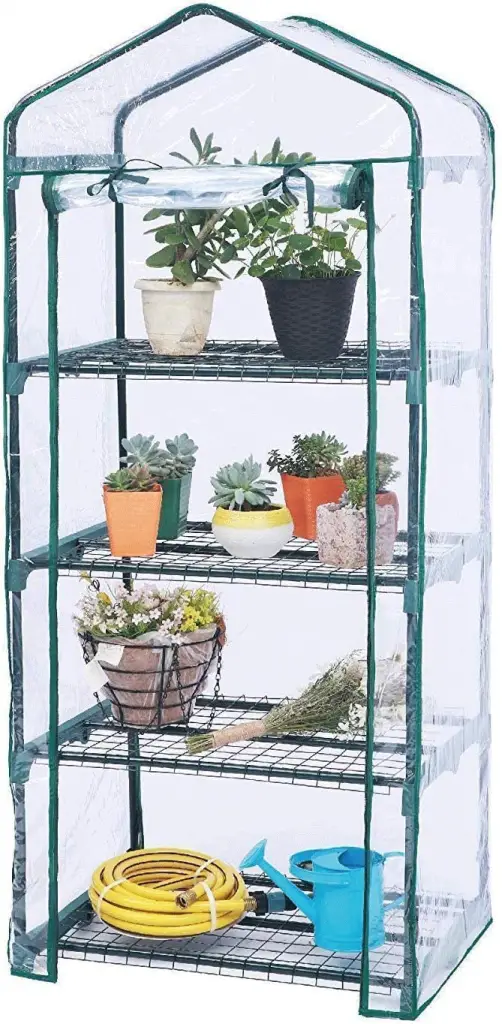
Rating: 4.4/5
The Worth Garden greenhouse has a durable steel frame with PVC covers, making it rust-resistant. Despite having 4 tiers, the unit assembly is straightforward and requires no tools. Each level has a 23.4lb weight capacity, allowing several pots to be placed at once. The zipper roller door is suitable for the needed ventilation.
If there was one complaint about this greenhouse is that the shelves can easily slip out of place. While this problem can be rectified by using a zip-tie to keep them in place, a lock system should have been pre-installed.
Pros:
- Good value for money
- Sturdy frame
- Can house several lightweight plants
Cons:
- Needs a lock system for the shelves
2. SUNGIFT 4-Tier Greenhouse With Wheels
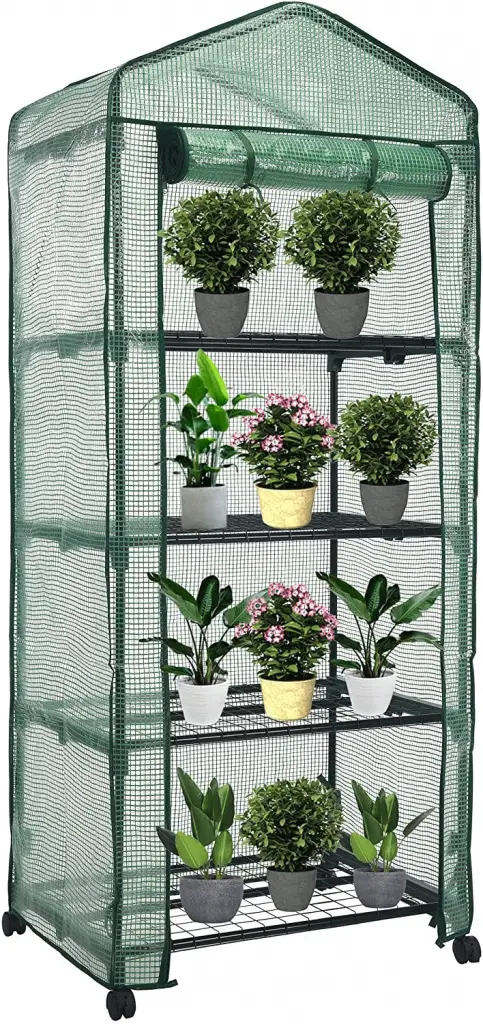
Rating: 4.3/5
The SUNGIFT greenhouse has 4-tiers with screened ventilation and casters to move the unit around easily. This unit gets a shoutout in my best indoor greenhouse list primarily because of its portability. Moreover, the casters can be removed, and once on, they come with dual locks that click in place so the greenhouse does not move.
The assembly and storage are pretty simple. The unit has plenty of room for small pot plants or seedlings. However, if you live in a windy area and have this unit on the balcony, you will need something solid to hold it down as it’s pretty lightweight against harsher winds.
Pros:
- 4-tiers hold plenty of small plants
- Removable casters come with locks
- Screened ventilation
Cons:
- Could be sturdier
3. Quictent Walk-in Greenhouse With 6 Shelves
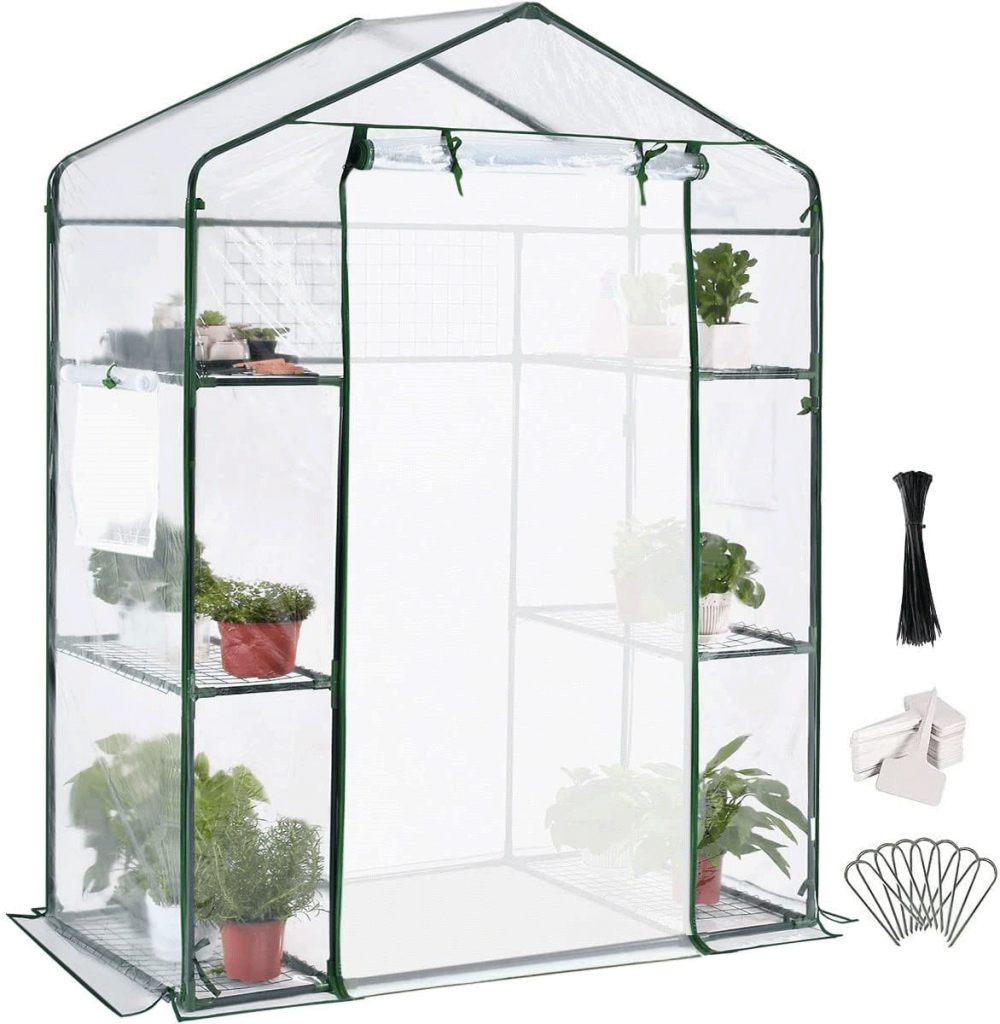
Rating: 4.3/5
The Quictent Walk-in Greenhouse deserved a spit on my best indoor greenhouse list for their well-thought-out design and additions that make it just that much better than competitors in the same price range. This model comes with zip ties to secure the shelving, often loose in this type of greenhouse. You also get T-type tags for your planter and S-shaped hooks to hang tools on the tools at the back of the structure. The side vets come with Velcro, which keeps them rightly packed. Finally, there is a bug screen under the zipper roller door, ensuring ventilation and protection.
While there isn’t much wrong with this greenhouse, I did notice that after one growing season, the covers wear off significantly, especially during storage. So, you may not have this unit for long.
Pros:
- Bug screen
- Side vents have Velcro
- Comes with S-shaped hooks and T-type tags
- Zip ties to secure shelves
Cons:
- Noticeable wear-out after one season
FAQs
Are indoor greenhouses worth the money?
An indoor greenhouse is often an inexpensive way to grow herbs, fruits, vegetables, and flowers inside your home. Their cost-effectiveness and all-year-round use make them worth the money.
How can you keep your indoor greenhouse warm?
In warmer seasons, you keep an indoor greenhouse under direct sunlight next to a window or on a balcony. In colder seasons, or when there is little to no natural light, you can buy growing lights to mimic sunlight to keep the plants thriving.
